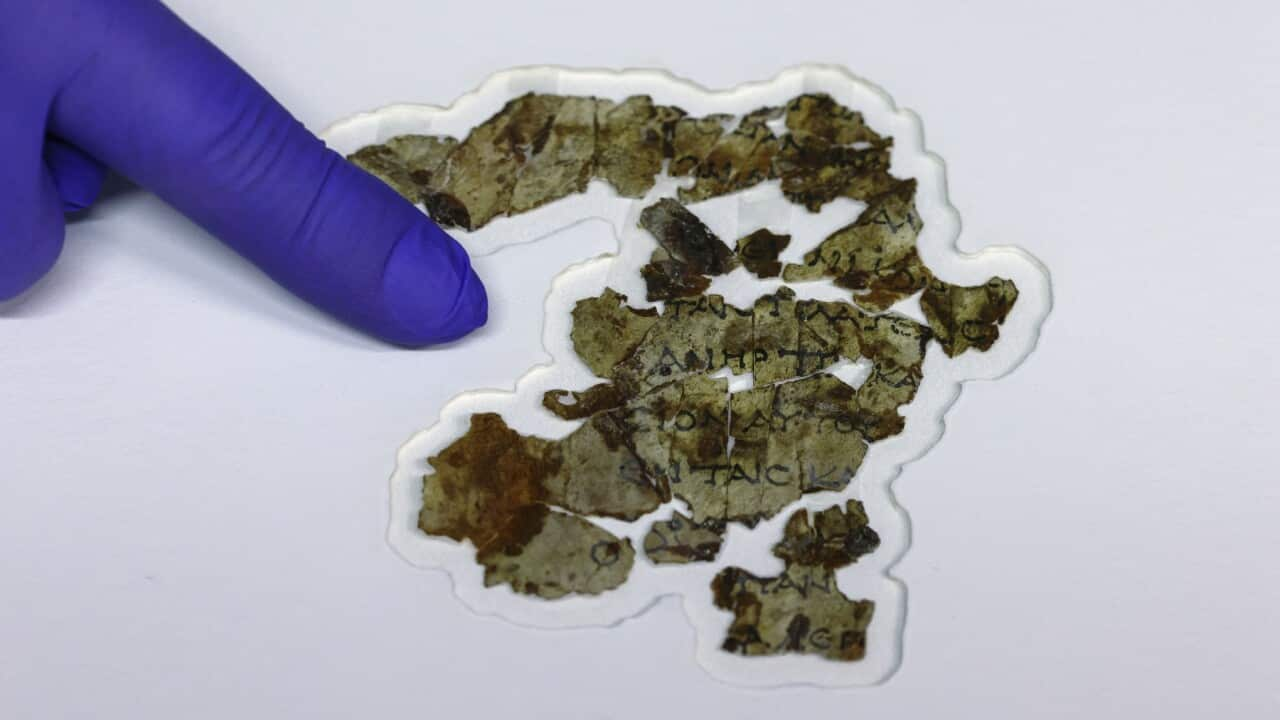Italian
Nelle gole di un deserto giudaico a sud di Gerusalemme, un gruppo di archeologi israeliani ha mappato centinaia di cavità grandi come caverne lungo una striscia di 80 chilometri.
La maggior parte delle caverne erano riempite di rifiuti vecchi di centinaia d’anni e sabbia.
Ma recentemente sono comparsi sul mercato nero nuovi frammenti di manoscritti e pergamene.
Haim Cohen dell’Israel Antiquities Authority sostiene che ciò suggerisca che dei predoni abbiano scoperto qualche tipo di bottino.
"After a lot of years of that, looters are coming in the caves to loot all the amazing stuff: coins, basketries, clothes and scrolls, of course, inside the cave... IAA went to survey and excavate in the caves in the desert to find these artefacts before the looters."
La squadra dell’Authority ha aumentato i suoi sforzi, venendo ricompensata con la scoperta di manoscritti contenenti le copie conosciute più antiche di un testo biblico.
Il ricercatore dell’Authority sui Manoscritti del Mar Morto Oren Ableman ha dichiarato che si tratta della prima volta in 60 anni che vengono trovati nuovi manoscritti nell’area.
"It's important also because it's the first time when such fragments are found in an excavation and brought straight here to our laboratory, which meant that we have better documentation of their condition than anything, any other previous discovery of the Dead Sea scrolls."
I Manoscritti del Mar Morto sono una collezione di antichi testi giudaici trovati per primi da nomadi beduini locali nelle caverne di Qumran nel 1947.
I manoscritti offrono degli spaccati della società e religione giudea prima e dopo Gesù.
E le ultime scoperte della Israel Antiquities Authority appartengono alla stessa collezione.
"We found one fragment from the book of Zachariah, Chapter eight, verses 16 to 17. We also found another small fragment from the book of Nahum, Chapter one, verse five. These are parts of a longer scroll that contained all the 12 minor prophets in a translation into Greek."
Nel 1961, l’archeologo israeliano Yohanan Aharoni fece degli scavi in una caverna a sud di Gerusalemme, conosciuta localmente come la Caverna dell’Orrore.
Lo studioso trovò dei frammenti di manoscritto da un libro della Bibbia Ebraica, i dodici Profeti Minori.
Oren Ableman ha rivelato che si tratta del libro a cui gli 80 frammenti appena scoperti appartengono.
"So these are new pieces of the puzzle and we can add them to our greater picture of the period and of the text. And even though these pieces are small, they did give us some new information that we did not know before."
Gli esperti credono che questi frammenti vennero nascosti nella caverna tra il 132 e il 136 DC, durante una rivolta giudea armata contro il regno dell’imperatore Adriano.
Tra gli artefatti di epoca romana c’erano altre scoperte ben più antiche, come lo scheletro mummificato di un bambino vecchio di 6000 anni ed un’enorme cesta intera intrecciata del periodo neolitico, risalente a 10,500 anni fa.
English
In the canyons of the Judean desert south of Jerusalem, a group of Israeli archaeologists have been mapping hundreds of cave-side hollows along an 80-kilometre strip.
Most often the caves were filled with centuries-old debris and sand.
But recently, new pieces of scrolls and parchment appeared on the black market.
Israel Antiquities Authority Haim Cohen says it hinted robbers had uncovered some bounty.
"After a lot of years of that, looters are coming in the caves to loot all the amazing stuff: coins, basketries, clothes and scrolls, of course, inside the cave... IAA went to survey and excavate in the caves in the desert to find these artefacts before the looters."
The Authority's team boosted their efforts and were rewarded when they found scrolls including the earliest known copies of a biblical text.
Dead Sea Scroll researcher with the Authority, Oren Ableman, says it's the first time new scrolls have been found in the area in 60 years.
"It's important also because it's the first time when such fragments are found in an excavation and brought straight here to our laboratory, which meant that we have better documentation of their condition than anything, any other previous discovery of the Dead Sea scrolls."
The Dead Sea Scrolls are a collection of ancient Jewish texts first found by local Bedouin nomads in the caves of Qumran in 1947.
They provided insights into Jewish society and religion before and after Jesus.
And the Israel Antiquities Authority's latest discoveries belong to the same collection.
"We found one fragment from the book of Zachariah, Chapter eight, verses 16 to 17. We also found another small fragment from the book of Nahum, Chapter one, verse five. These are parts of a longer scroll that contained all the 12 minor prophets in a translation into Greek."
In 1961, Israeli archaeologist Yohanan Aharoni excavated a cave south of Jerusalem known locally as the Cave of Horror.
He found parchment fragments of a scroll from a book in the Hebrew Bible, the Twelve Minor Prophets.
Oren Ableman says it's a book the 80 newly discovered fragments are related to.
"So these are new pieces of the puzzle and we can add them to our greater picture of the period and of the text. And even though these pieces are small, they did give us some new information that we did not know before."
Experts believe these pieces were hidden in the cave between 132 and 136 AD, during an armed Jewish uprising against the reign of Emperor Hadrian.
Alongside the Roman-era artefacts were far older discoveries, like a 6,000-year-old mummified skeleton of a child and an immense, complete woven basket from the Neolithic period dating back 10,500 years.
Report by Nadine Silva





